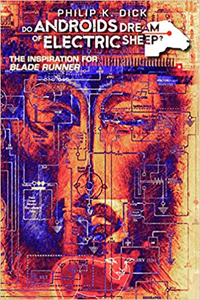The marketing approach and selected quotes about the “Do Androids Dream of Electric Sheep” comic adaptation (2009-11, Boom! Studios) is all wrong. The Village Voice says on the back cover of each volume: “If you’re a fan of ‘Blade Runner’ but have never read the source material, this experimental adaptation should be just the ticket.”
Mini-cliffhangers
No way. This 24-issue (or six volume) project will likely cost you over $100 (because of its breadth, not deluxe pricing). (I utilized my local library.) The target audience is Philip K. Dick nerds who want to read “DADOES” yet again, but in a new way.
I also quibble with “experimental.” Granted, the idea of adapting a novel into a comic word for word is unique. But “experimental” suggests an original idea that doesn’t turn out great, although it was worth the ole college try.

“Do Androids Dream of Electric Sheep?” (2009-11)
Boom! Studios, 24 issues
Writer: Philip K. Dick
Art: Tony Parker
Colors: Blond
Letters: Richard Starkings
Artist Tony Parker and colorist Blond’s series is great. I didn’t take to it in the first issue, or even the first few. Letterer Richard Starkings includes the “he said”s and “she said”s, which aren’t necessary when we can see the word bubbles. But I got over it and got into the flow.
I enjoyed experiencing this familiar story in a new way. Dick’s novel is 21 chapters; the adaptation is 24 issues. As such, the issue breaks don’t line up with chapter breaks. Dick uses chapter breaks for scene changes. The comic uses issue breaks as mini-cliffhangers, although they are cerebral cliffhangers.
For instance, Issue 1 ends with Deckard pulling out a sheet about the Nexus-6 models. So something Dick breezes through becomes something we pause to think about. I love that Dick treats big and small moments with the same emphasis – it’s one of the idiosyncrasies that make his writing so amusing. But I appreciate that Parker emphasizes new things.
A slowed-down experience
Overall, Parker’s comic is a slower consumption experience; we read the words but also look at the pictures. I latched onto different things. Each reader will likely have their own new revelations.
As for the pictures, they are worth looking at. Parker effectively overcomes the shadow of “Blade Runner” by hewing closely to Dick’s descriptions.
Here’s how he draws the main characters: Deckard is a typical mid-level-IQ cop. He’s smart enough to do his job as a bounty hunter, but he’s perpetually dazed.
Long-haired, gangly and stooped Isidore is like a hobo we’re conditioned to stay away from. But if we get close, we’d find he’s actually a nice guy. Baty is thickset and wears suspenders. Rachael and Pris are identical dark-haired girls, as per PKD’s novel.

The comic brushes aside “Blade Runner” biases in a way Dick’s prose can’t do on its own (especially if you have the tie-in novel with Harrison Ford and Sean Young on the cover).
Kipple and blue exhaust
Parker deliciously strews every location with kipple, and gives us wide shots of the empty ruins, outdoors in San Francisco and inside Isidore’s vast apartment building.
The hovercars are more generic than “BR’s” iconic spinners, but Parker and Blond (who favors rich shades of gray, dodging “BR’s” neon) fill panels with electric-blue exhaust. There’s space to fill the air with smoke because there’s no other traffic.
“DADOES” is a think piece more than an action piece, yet Parker is up to the challenge. He resists the temptation to have Starkings write blocks of prose in the manner of “Watchmen.” Instead, he draws what Deckard is thinking. In one panel, Rick imagines he himself is an android, being gunned down.
Thoughts are not real, so Parker is free to draw Deckard’s metaphorical vision of androids as the bounty hunter struggles to see them as “other” even though they are not readily distinguishable from humans.
So he imagines them with “Terminator” endoskeletons. As fans know, that’s not how they really are. (Dick added to the confusion by using the word “androids,” but perhaps the meaning was still being negotiated prior to the “droids” of “Star Wars,” which are mechanical.)
A PKD celebration
Even as I try to stay focused on the comic itself, I can’t help but get wrapped up in Dick’s writing – and in part, Boom!’s project is a celebration of exactly that. Every issue features essays from comic people and PKD scholars about their personal relationship to Dick’s work (these are collected in the volumes too).
Several essays hit on the Dickian lore we know by heart (which admittedly supports the idea of casual readers as the target audience). But some are insightful.
Jonathan Lethem shows how his writing is forever influenced by PKD, while David Mack explains how he deliberately made his comic expansion of “Electric Ant” adhere to Dick’s principles. Keith R.A. DeCandido outlines how Dick is a world builder whereas a Ridley Scott is a character builder. Ted Kosmatka argues that PKD’s appeal comes from readers’ increasing suspicions that he was right about everything.
The essays aren’t consistent in quality or varied in subject enough to make a de facto “DADOES” analysis book. But since they are essentially bonus features, I’m not offended by the weak entries.
The “Do Androids Dream of Electric Sheep?” comic adaptation immerses a reader in the novel itself and PKD in general. It’s not a punchy adaptation; it’s a brainy deep-dive. It’s not the ideal starting point for a tip-toeing, casual reader. For PKD nerds, it’s a treasure.

